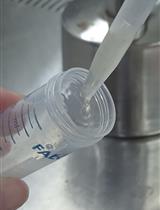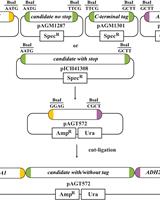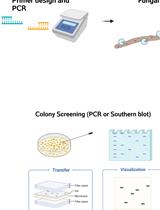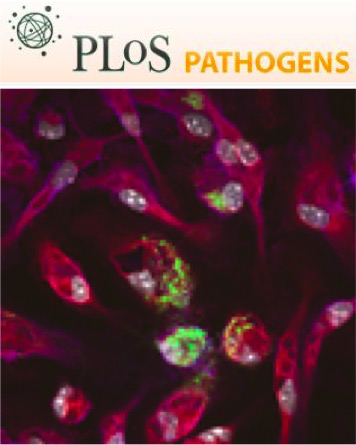- Submit a Protocol
- Receive Our Alerts
- Log in
- /
- Sign up
- My Bio Page
- Edit My Profile
- Change Password
- Log Out
- EN
- EN - English
- CN - 中文
- Protocols
- Articles and Issues
- For Authors
- About
- Become a Reviewer
- EN - English
- CN - 中文
- Home
- Protocols
- Articles and Issues
- For Authors
- About
- Become a Reviewer
Genetic Transformation of Candida glabrata by Heat Shock
(*contributed equally to this work) Published: Vol 5, Iss 14, Jul 20, 2015 DOI: 10.21769/BioProtoc.1529 Views: 9200
Reviewed by: Fanglian HeEmmanuel Zavalza

Protocol Collections
Comprehensive collections of detailed, peer-reviewed protocols focusing on specific topics
Related protocols

Phytophthora sojae Transformation Based on the CRISPR/Cas9 System
Jingting Cao [...] Yuanchao Wang
Mar 20, 2022 3347 Views

Simple Growth Complementation Assay in Yeast
Robert Fuhrmeister and Jana Streubel
Aug 5, 2023 1954 Views

Gene Replacement by a Selectable Marker in the Filamentous Fungus Magnaporthe oryzae
Nalleli Garcia [...] Jessie Fernandez
Sep 5, 2023 1980 Views
Abstract
Here, we report a method for the transformation of Candida glabrata using a heat shock method. The protocol can be used for transformations in single well or in 96-well scale. It has been employed as an alternative method to the electroporation protocol to construct a genome-scale gene deletion collection in the human fungal pathogen Candida glabrata ATCC2001 and related strains. Furthermore, the protocol can be used to generate gene deletions in clinical isolates of Candida glabrata (C. glabrata).
Keywords: Candida glabrataMaterials and Reagents
- Recipient strain [ATCC2001, HTL or clinical isolates (Schwarzmuller et al., 2014)]
- DNA deletion construct/transforming DNA
- Sterile water (double distilled)
- Bacto™ peptone (BD Biosciences, catalog number: 211820 )
- Bacto™ yeast extract (BD Biosciences, catalog number: 212720 )
- Bacto™ agar (BD Biosciences, catalog number: 214030 )
- Glucose (Merck KGaA, catalog number: 108337 )
- Lithium acetate dehydrate (LiAc) (Sigma-Aldrich, catalog number: L6883 )
- Dimethyl sulfoxide (DMSO) (Sigma-Aldrich, catalog number: 472301 )
- Polyethylene glycol (PEG 3350) (Sigma-Aldrich, catalog number: P4338 )
- Nourseothricin-dihydrogen sulfate (Werner BioAgents, catalog number: 5.0 )
- ssDNA (Sigma-Aldrich, catalog number: D1626 )
- YPD media (see Recipes)
- Solid selective media (see Recipes)
Equipment
- Deep well plate (96-well) (Nunc®, catalog number: 732-2662 )
- Reservoir (autoclavable) (VWR International, catalog number: 6130466 )
- Multichannel pipette (200 µl) (Brandt Transferpette, WU2160016)
- Culture flasks with baffles
- Centrifuge (50 ml tubes) (Eppendorf, catalog number: 5702R )
- Centrifuge (1.5 ml tubes) (Eppendorf, catalog number: 5417R )
- Rotary shaker for culture flasks (New Brunswick Scientific, catalog number: innova44 )
Procedure
- Culture preparation
- Grow background strains overnight in YPD media at 30 °C with shaking in flasks at 160 rpm.
- Dilute the culture into fresh YPD medium to an OD600 of about 0.3, and regrow until an OD600 of 1.5 is reached (for 96-well heat shock transformations, 600 ml of culture are required).
- Harvest cultures in 50 ml Falcon tubes by centrifugation at 1,000 x g for 5 min.
- Grow background strains overnight in YPD media at 30 °C with shaking in flasks at 160 rpm.
- Treatment of cells
- Wash cell pellets twice with 25 ml of sterile water, centrifuge and discard supernatants. Resuspend cell pellets gently in 1 ml of 100 mM LiAc.
- Combine all cell suspensions from one strain in two 50 ml tubes.
- After centrifugation at 1,000 x g for 30 sec, add the following sterile solution for each 50 ml of cells grown in step 1 in the order they are listed:
1,920 µl 50 % PEG-3350
400 µl ssDNA (10 mg/ml; heat-denatured)
288 µl of 1 M LiAc
- Gently resuspend cells by aspirating with a pipette.
- Wash cell pellets twice with 25 ml of sterile water, centrifuge and discard supernatants. Resuspend cell pellets gently in 1 ml of 100 mM LiAc.
- Heat-shock
96-well scale
- Prior to preparing competent cells, place 50 µl of transformation DNA constructs at the bottom of wells of a deep well plate.
- Add 326 µl of cell suspension to each well and mix gently by aspiration with a multi-channel or single-channel pipette. Seal the plate using a breathable adhesive foil.
- Incubate plates for 30 min at 30 °C in an incubator without shaking.
- Add 45 µl of DMSO and mix immediately by aspirating with a pipette.
- Incubate plates at 42 °C in an incubator without shaking for exactly 15 min.
- Centrifuge plates at 1,000 x g for 5 min and remove supernatants.
- Add 950 µl of YPD media and gently resuspend fungal cells by aspirating with a pipette.
Single-well scale
- Add 326 µl of the cell suspension to a 1.5 ml tube containing 50 µl transformation DNA constructs and gently mix by aspirating.
- Incubate tubes at 30 °C for 30 min. Add 45 µl of DMSO and mix immediately.
- Incubate tubes at 42 °C for exactly 15 min without agitation.
- Sediment cells by centrifugation at 1,000 x g for 5 min and remove supernatants by aspiration.
- Add 950 µl of YPD medium and gently resuspend cells.
- Prior to preparing competent cells, place 50 µl of transformation DNA constructs at the bottom of wells of a deep well plate.
- Regeneration of cells
- Incubate microtiter plates or tubes at 30 °C for 1 to 4 h at 30 °C without shaking.
- Afterwards, centrifuge tubes or plates at 1,000 x g for 5 min.
- Discard supernatants and resuspend cell pellets in 100 µl of sterile water.
- Plate cell suspensions on selective medium and incubate the plates at 30 °C for a few days until colonies become visible.
- Incubate microtiter plates or tubes at 30 °C for 1 to 4 h at 30 °C without shaking.
Notes
- This transformation protocol was optimized for C. glabrata ATCC2001 and all derived strains, as well as for clinical isolates of C. glabrata.
- The speed of rotary shaker depends on the type of culture flasks used. Flasks without baffles require higher shaking speeds around about 220 rpm for good oxygenation.
- Handle cells VERY gently after adding LiAc (no vortex-mixing!) and keep them on ice. Add the LiAc after adding sterile water and TE buffer (this automatically dilutes the LiAc to the appropriate concentration).
- In section “Procedure” we mention that cell pellets should be resuspended carefully by pipetting. For this step we recommend a manual 1,000 µl pipette. By slow aspiration and release the cell pellet can be gently resuspended.
- The required regeneration time depends on the selective marker. We experienced that transformants with a HIS3 marker can be plated after 1 h, while those with a NAT1 marker may require up to 4 h of regeneration.
- The ssDNA solution is prepared according to the manual described in Molecular cloning (Sambrook and Russell, 2001). Each aliquot is heated to 95 °C for 5 min and immediately cooled on ice before use.
Recipes
- YPD media (yeast extract peptone dextrose)
25 g/LBacto ™ peptone
12.5 g/LBacto ™ yeast extract
2% glucose
- Solid selective media (nourseothricin)
25 g/LBacto™ peptone
12.5 g/LBacto™ yeast extract
2% glucose
2% agar
0.2 g/Lnourseothricin
Acknowledgments
We thank Suzanne Noble and Alexander Johnson for their advice in setting up the heat-shock deletion workflow for gene deletion in the 96-well format (Noble and Johnson, 2005). This work was supported by the Austrian Science Foundation FWF through the ERA-Net Pathogenomics project FunPath (FWF-API-0125), and in part by grants from the Christian Doppler Society, the FP7 EC project FUNGITECT, the Marie-Curie ITN ImResFun (MC-ITN-606786) and the FWF Project FWF-P25333 "Chromatin" to KK.
References
- Noble, S. M. and Johnson, A. D. (2005). Strains and strategies for large-scale gene deletion studies of the diploid human fungal pathogen Candida albicans. Eukaryot Cell 4(2): 298-309.
- Schwarzmuller, T., Ma, B., Hiller, E., Istel, F., Tscherner, M., Brunke, S., Ames, L., Firon, A., Green, B., Cabral, V., Marcet-Houben, M., Jacobsen, I. D., Quintin, J., Seider, K., Frohner, I., Glaser, W., Jungwirth, H., Bachellier-Bassi, S., Chauvel, M., Zeidler, U., Ferrandon, D., Gabaldon, T., Hube, B., d'Enfert, C., Rupp, S., Cormack, B., Haynes, K. and Kuchler, K. (2014). Systematic phenotyping of a large-scale Candida glabrata deletion collection reveals novel antifungal tolerance genes. PLoS Pathog 10(6): e1004211.
- Sambrook, J. and Russell, D. W. (2001). Molecular cloning: A laboratory manual. 3rd edition, Cold Spring Harbor Laboratory Press, Cold Spring Harbor, NY, USA
Article Information
Copyright
© 2015 The Authors; exclusive licensee Bio-protocol LLC.
How to cite
Istel, F., Schwarzmüller, T., Tscherner, M. and Kuchler, K. (2015). Genetic Transformation of Candida glabrata by Heat Shock. Bio-protocol 5(14): e1529. DOI: 10.21769/BioProtoc.1529.
Category
Microbiology > Microbial genetics > Transformation
Molecular Biology > DNA > Transformation
Do you have any questions about this protocol?
Post your question to gather feedback from the community. We will also invite the authors of this article to respond.
Tips for asking effective questions
+ Description
Write a detailed description. Include all information that will help others answer your question including experimental processes, conditions, and relevant images.
Share
Bluesky
X
Copy link










